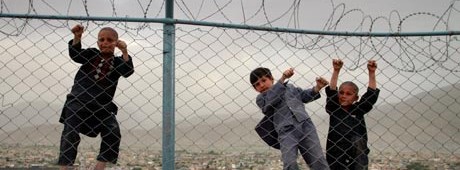Afghan Civilians Intentionally Targeted by NATO/ISAF Forces
![]() Careful examination of numerous reports, and images/video footage, along with eye-witness and victim testimonies, clarify that Afghan civilians are the main targets of deadly attacks by the North Atlantic Treaty Organization (NATO) and International Security Assistance Force (ISAF).
Careful examination of numerous reports, and images/video footage, along with eye-witness and victim testimonies, clarify that Afghan civilians are the main targets of deadly attacks by the North Atlantic Treaty Organization (NATO) and International Security Assistance Force (ISAF).
Although the Coalition forces claim that previous civilian massacres were accidental, Afghan-led peace movements believe that the killings are at best negligent at worst intentional in nature.
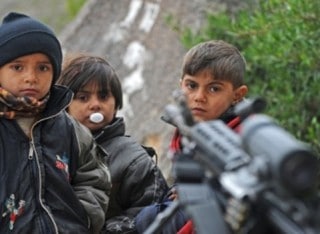
Foreign military presence and intervention in the past ten years has worsened the Afghanistan situation while civilian casualties have increasingly created tension between the Coalition forces, the Afghan government, and the people of Afghanistan.
These events have further brought into perspective the sheer human and material damages of the war. No one should become accustomed to or believe in this illogical method of bombing the country to peace.
This mentality is not justifiable and should not be the norm. Acts of violence must always be questioned. The people of Afghanistan want justice and accountability. Not surprisingly, they get the usual response from NATO – an initial denial of civilian casualties, a shift of blame on insurgency, occasional investigations with admittance to a tweaked number of civilian deaths, and rarely a contrived apology. This has become a wanton pattern. Explaining away repeated deadly civilian attacks as “mistakes” is unacceptable. Furthermore, this proves that the military solution to Afghanistan is not a viable option.
NATO-led forces are equipped with the most advanced technology with the capability of zooming in on even the smallest of objects with precise vision. This begs the question as to why so many civilians are dying. To put it into perspective below is a compiled short summary of recent NATO attacks:
It was reported that a total of three civilian atrocities were committed by the Coalition forces within the last two weeks. The correct estimate is actually four.
- Alahsay district of Kapisa province (5 civilians) Feb 17, 2011
- Khoygani District of Nangarhar province (6 civilians) Feb 20, 2011
- Ghazi Abad District of Kunar province (60+ civilians) Four Day Operation February 17/18/19 (different reports)
- Mountains of Nanglam in Kunar province (9 children/boys) March 1st, 2011
In Kapisa province on Thursday, February 17th, Alahsay district Governor Mohammed Omari confirmed that five civilians were killed by an air strike from the NATO-led ISAF. The five civilians- three of them adult males and two children ages 12 and 13 – were reported without meat for the last few months and were desperate to hunt, hence why they were carrying bird hunting equipment.
In Nangarhar province on February 20th, an entire family of six was killed by a NATO air strike into their home in the Khoygani district. A photo captured by Reuters shows that the missile directly hit the roof of the family’s home. The parents and their four children were all inside when the reportedly stray missile landed in their residential community. The father was a soldier for the Afghan National Army who died of excessive bleeding after troops delayed his arrival at a hospital.
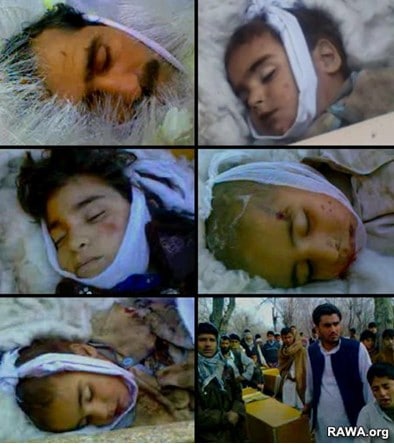 After a four-day operation by ISAF and NATO in the Ghazi Abad District of Kunar over 65 civilians were killed, and this was confirmed by the governor of the province. More than half of the casualties were women and children. Contrary to the abundant evidence, NATO claimed no civilians were killed and later insisted that insurgents were among the deceased, although villagers rejected this assertion.
After a four-day operation by ISAF and NATO in the Ghazi Abad District of Kunar over 65 civilians were killed, and this was confirmed by the governor of the province. More than half of the casualties were women and children. Contrary to the abundant evidence, NATO claimed no civilians were killed and later insisted that insurgents were among the deceased, although villagers rejected this assertion.
Two reports from the Afghan investigation team:
“As soon as the villagers heard the shooting and planes roaring overhead, they all struggled to take refuge in an old trench that was used by the mujahedeen during jihad [against the Russians].”
“Those who succeeded in reaching the trenches were killed when the trench collapsed after it was hit by rockets or bombs being fired from coalition helicopters,” he said. “Those who were on their way to the trench were killed by rockets or bullets. I visited the trench. I saw old, dried blood. I saw women’s and children’s garments. I saw blood-stained walls of the trench. I saw pieces of blankets and cotton from the quilts the villagers wrapped themselves in because of the cold weather.”
In an attempt to hide the news story ISAF detained two Al Jazeera journalists, Abdullah Nizami and Saeedullah Sahel during the investigation of the Kunar massacre. Samer Alawi, the Al Jazeera bureau chief in Kabul, strongly described the detentions of Nizami and Seedullah as repressive acts since it kept them from reporting. Another report released this past month by Columbia Journalism Review has documented the difficulty of reporting honest accounts of the Afghanistan war.
On March 1st, NATO helicopters killed 9 Afghan boys and injured one. This occurred without any warning signals as the children were targeted “one after another”. Aged seven to nine years old, the boys were from poor families and were collecting firewood in the mountains. This is once again an attack on the young children of Kunar. How is it that NATO soldiers, again, confused children for insurgents, and this time by gunfire?
General David H. Petraeus apologized for this killing, yet regarding the previous attack in Kunar (that killed over 65 civilians), he erroneously accused the Afghan parents of intentionally burning their children due to cultural practices of the discipline. Hamid Karzai’s spokesman Waheed Omar described the US General’s comments as being “outrageous, insulting and racist.” Karzai, himself, has rejected the apology. Mohammed Bismil, the brother of two of the boys killed, did not care for Petraeus’ apology but said, “The only option I have is to pick up a Kalashnikov, RPG [rocket-propelled grenade], or a suicide vest to fight.”
The father of two of the boys killed cried, “They don’t value humanity and don’t care about our children.”
Waheed Mujda, an Afghan political analyst stated that “[for international forces], Afghan people’s blood is of no value. For Americans, apologizing for a mistake is a very big deal but for Afghans, it is not. ISAF troop actions that raise anger among Afghans are a major reason for people joining the insurgents or Taliban.”
These are the four war crimes committed by the Coalition forces in the past two weeks. Victimization and the feeling of betrayal continue to spread all across Afghanistan.
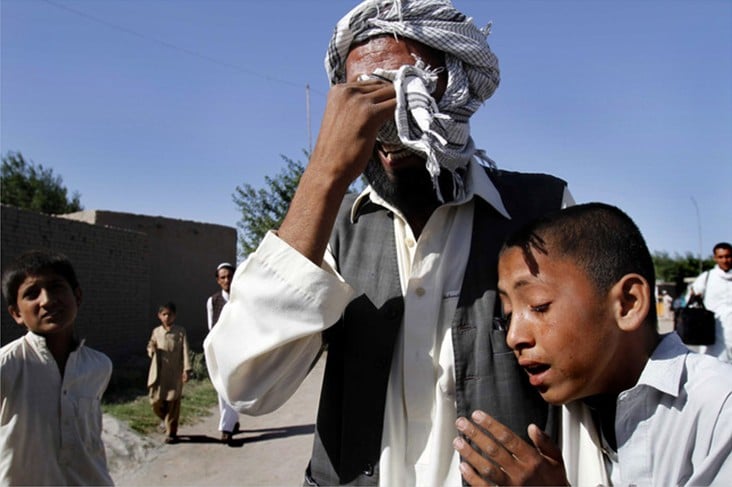
While this article initially started on the four recent attacks by NATO, it is important to look at the previous events as well. In doing so, we realize that these are not isolated incidents or simply negligence but an ongoing pattern of the failures of the “military solution to Afghanistan”.
Apologies from the Coalition, as rare as they are, mean little to nothing to Afghans. Months earlier in 2010, after initially choosing not to investigate, NATO forces offered an apology for killing a fourteen-year-old girl. Her father Mohammad Karim simply responded, “Now, what should I do with ‘sorry’?”
Earlier in Nangarhar, in May 2010, when NATO soldiers raided a home shooting at least nine civilians indiscriminately, a mourner said:
“If the Americans do this again, we are ready to shed our blood fighting them. We would rather die than sit by and do nothing. If there was anyone here trying to destroy our country, we would capture them and hand them over to the government. It is our land and our duty to defend it against both foreigners and insurgent infiltrators.”
He spoke further on this by saying, “If the military keeps doing this, the people will go into the mountains to fight them. When I saw my daughter injured, all I could think about was putting on a suicide jacket.”
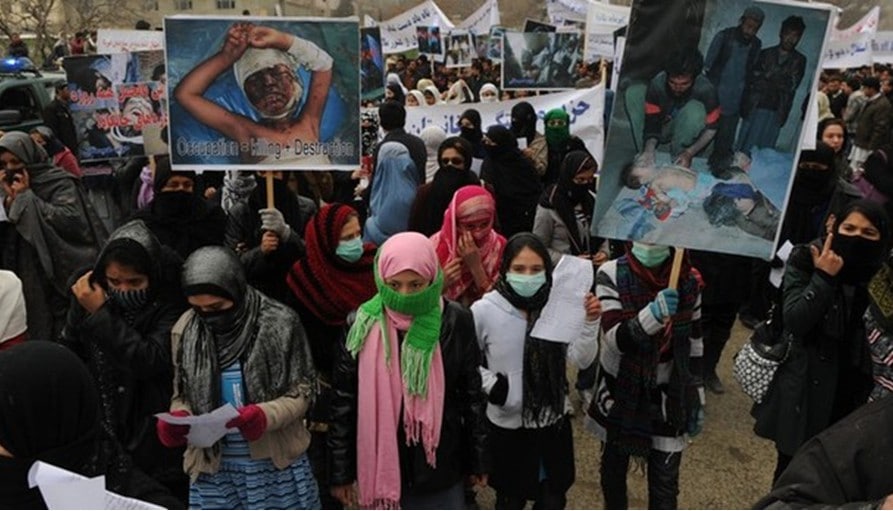
Last month was the one-year anniversary of the killing of two pregnant mothers, men, and a teenage girl by a NATO night raid. In an attempt to cover it up, the US forces literally dug the bullets out of the victim’s bodies. In a Democracy Now interview Glenn Greenwald said, “Here you have an incident that we know about only because of sheer luck with the determination of a single reporter, and again the military lying about what took place.” A recent report on survivors of night raids gives a close look at how foreign troops justify killing civilians. One witness of night raids, Anwar Ul Haq, said, “Whenever they shoot or kill anybody, they call him al Qaeda whether he is or not.”
Without regard for civilians, the Tarok Kolache village in Afghanistan’s Arghandab River Valley was completely destroyed by 25 tons of bombs. Is the destruction of entire villages, which are the support system for the majority of Afghans, a logical tactic in counter-insurgency? Clearly, the Afghans who have suffered due to this disagree. A farmer of the Arghandab district asked “Why do you have to blow up so many of our fields and homes?”, while one angry villager accused the military of ruining his life after the demolition.
In addition to witness and victim testimonies, the Coalition forces themselves have made eye-opening revelations on the target killings of civilians. In September 2010, it was revealed that a dozen US soldiers faced charges in their involvement of not only killing innocent Afghan civilians at random for sport, but also collecting the victim’s finger bones, leg bones, teeth, and skulls as trophies. The military refuses to release photos that show US soldiers posing with naked, mutilated, and charred corpses of their victims. Sound familiar?
The father of one of the victims killed was quoted as saying, “The Americans really love to kill innocent people.” In fact, they had planned on killing more civilians had it not been for one soldier, Spc. Adam Winfield and his father tried relentlessly to blow the whistle. He had said his squad leader “gives high-fives to the guy who kills innocent people and plans more with him.- I have proof that they are planning another one in the form of an AK-47 (machine gun) they want to drop on another guy.” Instead of honoring Winfield for exposing the truth, he was instead charged with the same crimes. His father had reported Winfield’s statements to Army officials, but they turned a blind eye. One can’t help but wonder whether the killing of civilians for sport is more abhorrent or the apparent negligence and silence by the higher-ups in the Armed forces.
Speaking of higher-ups in the Armed forces, General Mattis, who replaced Petreaus as chief of US Central Command, said “It’s fun to kill people…it’s a hell of a lot of fun to shoot [Afghans].” He continued: “Actually, it’s a lot of fun to fight. You know, it’s a hell of a hoot. It’s fun to shoot some people. I’ll be right upfront with you, I like brawling.” A bit later he spoke of the “emotional satisfaction you may get from really whacking somebody.”‘ He reportedly even told his troops to “have a plan to kill everybody you meet.”
Afghans have been resisting this dehumanizing way of life where they are regarded as savages or merely objects to be killed for sport. A recent poll conducted in Afghanistan shows that more than half of the Afghans interviewed believed NATO-led forces should begin withdrawing from the country in mid-2011 or sooner. Afghans no longer want anything from NATO but to simply leave. Massive protests and demonstrations against the Coalition following recent attacks are now erupting throughout Afghanistan in cities like Kunar, Kabul city, and Gangnam, where Afghan demonstrators have been marching in streets chanting, “death to the invaders” and “We don’t want the invading forces.” Another man explained, “We say to ISAF that revenge is part of our culture. We say to our leaders, our government, that this kind of violence should be investigated. Those responsible should be punished.” A woman held a placard that read, “Occupation = Killing + Destruction.” In one demonstration, angry protesters burned a pile of blankets, clothing, and other items donated by Coalition troops. An independent member in the legislature, Ramazan Bashardost, said: “These killings must be stopped or the people will rise against foreigners and we will stand by them.”
Civilians fear not only NATO and ISAF but also suicide bombings by Armed Opposition Groups. Simultaneously with the terror by Coalition forces, recent suicide blasts have taken the lives of around 100 Afghan civilians.
The almost decade-long war and occupation have done more harm than good, escalating violence in Afghanistan to its peak, and continuing to deteriorate chances of peace in the future. Afghanistan has already been subjected to previous decades of war and now each new generation is haunted by both the memory and reality of endless bloodshed, death, and misery. The fact remains that Afghans continue to live with hunger and worsening poverty, torture, and humiliation, planted with weapons, escalating air strikes, and night raids.
The responsibility lies on the Afghan government, Taliban, warlords, and especially NATO/ISAF forces, including top commanders like General Petreaus, who must be brought by the people of Afghanistan and the world through a judicial process to account for their crimes, failed military solutions, and indiscriminate killings. Instead, the corrupt system in power continues to leave Afghans helpless and without a voice and has them convinced that they are incapable of self-determination. However, it must not be forgotten that Afghanistan has a long history of independence and are more than capable of running its affairs. It is vitally important to listen to Afghans.
It is the right of the people to decide the fate of their country and there are no exceptions. With the recent revolts in Arab countries, it’s only a matter of time before Afghans follow their lead. This requires immediate change and an honest vision for a truly democratic Afghanistan. In doing so, we must be aware of the ground realities, namely the presence of NATO, Taliban, warlords as well as regional intervention.
Global Afghan-led peace groups such as Afghans for Peace (AFP), Afghan Youth Peace Volunteers (AYPV), and the Afghan Canadian Student Association (ACSA) stand in solidarity with the people of Afghanistan in their struggle for justice and freedom. They fully acknowledge and strongly condemn these cruel, targeted massacres of innocent human life. AFP, AYPV and ACSA call on the people of the world, especially Afghans, to rightfully demand an end to this illegal war and occupation. When children are being killed one by one, as was the case in Kunar last week, all of humanity suffers. When civilians have become the targets, it is time for everyone to stand up.
Signed by:
Afghans for Peace
Afghan Youth Peace Volunteers
Afghan Canadian Student Association
Afghan Perspectives

Hanan Habibzai, an investigative journalist with more than ten years of experience in global journalism has covered the US invasion of Afghanistan, the fall of the Taliban regime, and post-Taliban developments, including the rise of militancy in the country.
MA in global journalism from Coventry University, Hanan writes on the conflict in Afghanistan and the regional politics, his work has been published by the BBC Afghan Stream, Pajhwok Afghan News, Reuter’s news agency, the Washington Post, Veterans Today, several local and the global media agencies, Including contribution in a journalism book Afghanistan War and the Media: Deadline and Frontline (2010), edited by R, Keeble & J, Mair, Hanan’s academic work is published around the world.
ATTENTION READERS
We See The World From All Sides and Want YOU To Be Fully InformedIn fact, intentional disinformation is a disgraceful scourge in media today. So to assuage any possible errant incorrect information posted herein, we strongly encourage you to seek corroboration from other non-VT sources before forming an educated opinion.
About VT - Policies & Disclosures - Comment Policy

